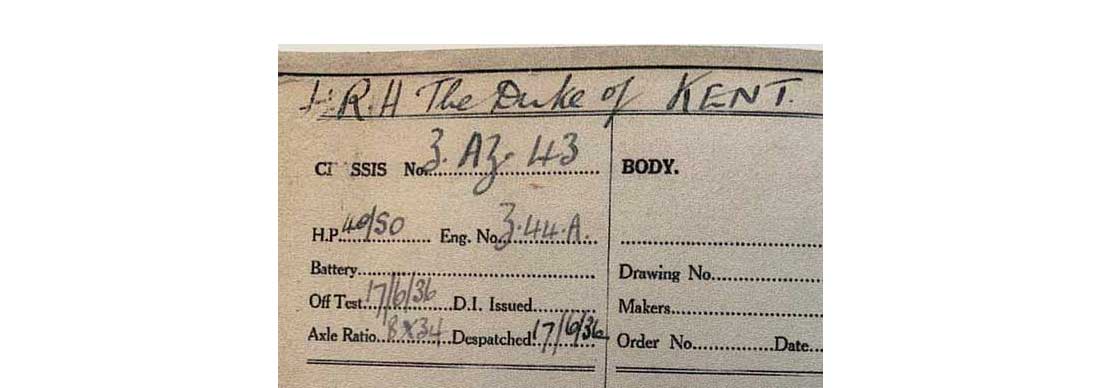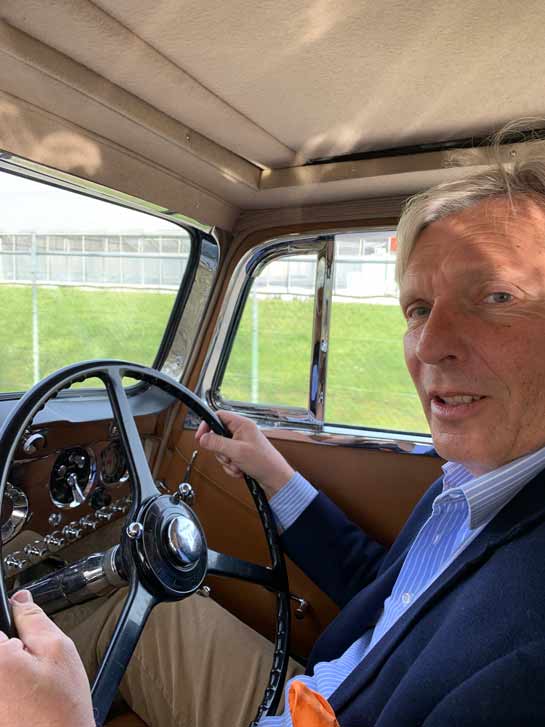
A unique Royal Rolls-Royce
Above: Chassis 3 AZ 43 was ordered new by HRH the Duke of Kent, youngest son of King George V.
1936 Rolls-Royce Phantom III Touring Saloon by Barker for HRH the Duke of Kent, chassis 3 AZ 43.
After a full year of travel crisscrossing Europe during the Covid crisis I am mentally knackered but emotionally fine! Being a classic-car consultant and finder has to be a job you love – you can’t do it if you don’t like it. The daily long-distance drives over sometimes restricted European borders, and the search for hotels and places to eat can be exhausting, but very rewarding at the same time: Lyon, Milan, Verona, Salzburg. Amsterdam one day, then Austria and Switzerland the next – no two days are ever the same in this business.
While I am contemplating my unpredictable life, I find myself wafting along Austrian roads behind the wheel of a very significant 1936 Rolls-Royce Phantom III Touring Saloon by Barker, a car ordered new by HRH the Duke of Kent, who was the youngest son of King George V.
HRH the Duke of Kent was born on 20 December 1902, and was christened Prince George Edward Alexander Edmund. As a seasoned RAF pilot, he knew a thing or two about cars. He kept a fine pair of Derby Bentleys in his stables, and apparently a very fast Buick straight-eight, but the Phantom III had always been his favourite.
According to The Motor magazine of July 1936: ‘Many of the owner’s ideas were incorporated in the lavishly equipped design.’ Perhaps the most prominent feature was the chrome-plated dashboard, with instruments marked with both imperial and metric units. A pure delight! The list of extras fitted was recorded in the original Rolls-Royce chassis records and is two pages long.

Above:Two pages of extras are listed on the original Rolls-Royce chassis cards.
On 21 July 1936, the car was delivered to the Prince’s London address, registered CYP1. He immediately took it on a European tour to Yugoslavia. Sadly, on 25 August 1942, four months short of his 40th birthday, the Duke of Kent was killed when his RAF Short Sunderland Mark III flying boat crashed into a hillside near Dunbeath, Caithness, in the far north of Scotland. Various conspiracy theories have emerged over the years about the mysterious circumstances of this incident. One unsubstantiated claim suggested that the Duke was on a secret solo peace mission to Sweden to open fraudulent peace talks with a German general, which would have been very much at odds with Churchill’s ‘never surrender’ policy.

Above: The Duke of Kent in 1938 with chassis 3 AZ 43, his favourite car.
However, the Phantom was patiently waiting at the RAF station at Invergordon for its master’s return. After the flying accident, the car was taken to a Rolls-Royce dealer and quietly sold after the war, on 26 April 1949, to a Mr J. Donaldson Hudson Esq of Market Drayton. I am pretty sure Mr Hudson, possibly an American, never knew about the original owner of the car.
Today, the Phantom is part of an important European collection of Rolls-Royce motor cars, and it is in mint condition. I was allowed to use it for two days, and I decided to take a trip through Austria and Switzerland using mostly empty country roads and some Autobahns. You may think, this is unusual territory for a Phantom III, but not for this one – it goes like stink!

Above: The Phantom III is a gem to drive. Controls are precise and pleasant with no noise or vibrations noticeable on European Autobahns.
Much has been written about Phantom IIIs over the years, but reading past reports I suspect not many of the reviewers have ever taken them out for real drives along European motorways. This Phantom loves them, behaving very much like a modern luxury car, with precise steering, fine all-round independent suspension, powerful brakes and a very willing 7.3-litre V12 engine. I averaged 75mph, with little noise and no vibration.

Above: A refined chrome dashboard carries a unique selection of instruments, including the original Motorola radio. The top panel is finished in lacquered piano black. A joy to behold.
In the engine, you can feel the heritage of the Rolls-Royce R V12 powerplants built for the Schneider Trophy Supermarine S.6 and S.6B seaplanes in 1929 and 1931, which also propelled the S.6B to a then-record airspeed of 407.5mph. The Rolls-Royce R engine was the predecessor to the Merlin used to power the Spitfire and many other World War II aircraft. Sir Henry Segrave, Sir Malcolm Campbell and his son Donald all used Rolls-Royce V12 engines for various land- and water-speed record machines. Later, the much developed Rolls-Royce Griffon, which remained in production until 1955, and was the last in the line of Rolls-Royce’s V12 aero engines was used in later-mark Spitfires, the Fairy Firefly, Avro Shackleton and other aircraft.

Above: The unique instrumentation features both imperial and metric units.
Many collectors, however, remain unconvinced about the Phantom III. I do wonder if the car was ever properly compared with its contemporary rival, the Mercedes 540K Innenlenker with Kompressor. In my experience, the Phantom III is the much more refined car. In comparison, the ‘Kompressorwagen’ with its heavy controls, feels outdated – it is a difficult animal, and very hard to steer. The Mercedes’ gear change is obstructive, and the chassis lacks the distinguished Rolls-Royce finesse. Driving a 500K or 540K Kompressor Mercedes always reminds me of navigating a Mercedes ‘Langschnauzer’ truck through a living room. Of course, the 500K and 540K are rather quicker than a truck, but I suspect I could still overtake a Kompressorwagen in a good 1930 Phantom II Continental with long gearing. It was easily the fastest pre-war Rolls-Royce built, and quicker than most contemporaries, including some Type 57 Bugattis.

Above: Wafting through the quiet Austrian countryside in the Phantom III is bliss.
I enjoyed the beautiful Austrian spring landscape in the Royal Phantom III, and this particular car turned out to be a real gem. I have to applaud the owner for its restoration and upkeep. It is easy to see why HRH the Duke of Kent loved this car so much. In 1936, it was a modern, sophisticated car. This automobile is a true masterpiece, and for me, on this day, certainly the best car in the world.

Above: A look under the bonnet reveals the magnificent 7.3-litre V12 engine in all its beauty.

Above: Power and refinement in abundance – the V12 has copious torque and propels the Phantom effortlessly.

Above: Rolls-Royce elegance at its finest.
Postscript: Another poignant Royal connection
While listening to Tchaikovsky‘s Concerto No.1 Op.23 on the old Motorola radio in the Phantom, I heard the news of the death of Prince Philip. I felt very touched to hear this sad message while driving a Royal car.
Prince Philip was another flying Royal who adored quality cars. I believe he owned an Alvis TD21 Drophead and a Lagonda Drophead, if I am not mistaken.
He was a much loved character, not only by the British, but also by many Europeans like me. God bless him.
Other articles by Michael




1 comment
This car is now imported to Slovakia.
Jan Skovajsa
Leave a comment
This site is protected by hCaptcha and the hCaptcha Privacy Policy and Terms of Service apply.